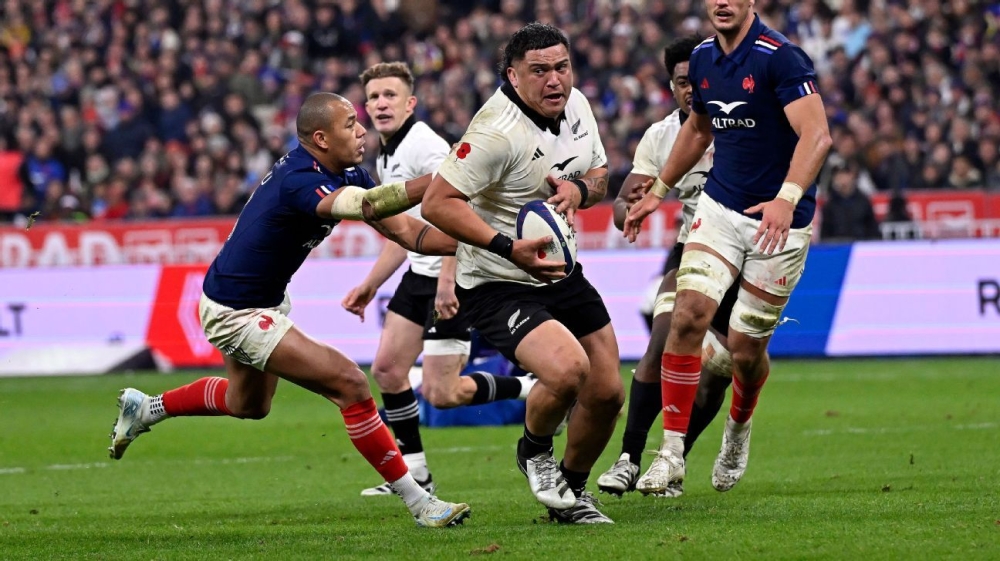All Blacks’ regeneration is ahead of the curve as veterans’ farewell arrives

A turbulent season that started with fumbles and endured many mid-year fades should finish with the promise of a bright future for the All Blacks.
Scott Robertson concludes his challenging maiden international season preparing the All Blacks for their 14th and final Test against Italy in Turin where a sub-zero temperature is forecast for kick-off.
When he returns home for summer, though, Robertson will reach for his shades.
The All Blacks, having suffered four losses this season including last week’s deflating defeat in Paris, are far from the finished product. But as an eternal optimist, Robertson will promote the positives. And in that regard, look no further than the emerging youth leading the way for the All Blacks.
Other than perhaps the resurgent Wallabies, following their worst Rugby World Cup in history, the All Blacks have been forced to regenerate more than any of their leading rivals.
Six influential figures, from centurions Sam Whitelock, Aaron Smith and Brodie Retallick to Richie Mo’unga and Shannon Frizell, that featured in last year’s World Cup final have been absent this season to promote the next in line.
While Robertson has adopted an inherently conservative selection approach, injuries have forced his hand and the All Blacks are now bearing the fruits of their next generation talent.
All told the All Blacks have ushered in 12 rookies to the Test scene this season. Many of those have, however, seen limited minutes against limited opposition.
Others, though, are front and centre in the starting team, having immediately stamped their mark to prove the future is now.
The theme of the All Blacks final week of the year will be largely based around farewelling former captain Sam Cane and veteran halfback TJ Perenara as both prepare for their last dances before bidding sayonara to cash in on the Japanese yen.
Fair enough, too. Servants such as those deserved to be honoured and praised for their sacrifice and contributions.
The overarching theme of the All Blacks season, though, is the compelling youth that is growing, learning on the job and will propel Robertson’s improving squad to many victories in the coming years.
Where else to start on with the All Blacks’ next gen talent than Wallace Sititi.
Nominated alongside South Africa‘s Sacha Feinberg-Mngomezulu, England’s Immanuel Feyi-Waboso and Ireland‘s Jamie Osborne for World Rugby’s breakthrough player of the year, Sititi should be the favourite to claim that gong after an exceptional rookie season.
From the moment Sititi was thrust into his maiden start against the world champion Springboks in Cape Town he’s oozed a sense of belonging rarely seen from a 22-year-old forward on the big stage. Whether he’s played blindside flanker or in his favoured No. 8 role Sititi’s ball carrying, offloads and lineout work have consistently impressed.
Sititi cutting England to shreds at Twickenham points to the dynamic athletic ability that has swiftly cemented him in the long-term future of the All Blacks’ loose forwards.
One area that sparked cold sweats before Robertson took charge was New Zealand’s second-row stocks. Whitelock and Retallick set the bar exceedingly high for such a prolonged period that no one was ever going to replace them. And while that remains true, Tupou Vaa’i has emerged to the point he is a strong contender for All Blacks player of the year.
Vaa’i was long earmarked as a successor to Whitelock and Retallick but no one expected him to stand up the way he has this season. His lineout work has excelled against the game’s best packs – from the Boks to England, Ireland and France. And around the field Vaa’i ranks among the world’s most mobile locks. It speaks volumes that Vaa’i has, for the most part, overshadowed All Blacks captain Scott Barrett. His task now is to continue his ascent. At 24, time is on his side.
Of the same raw vintage Tamaiti Williams is scratching the surface of his talent. Props bloom later than other positions – yet Williams is already proving a pivotal weapon. Despite his size, as one of the heaviest props in All Blacks history, Williams plays massive minutes and is starting to set standards for ball skills and mobility for those in low numbers. And in the last two Tests against Ireland and France Williams has come of age as a scrummaging force.
Others to impress in smaller sample sizes include Cam Roigard, the future for the All Blacks at halfback, after he outplayed Antoine Dupont, widely dubbed world’s best player, in Paris last week.
Peter Lakai, the compelling 21-year-old prospect, delivered definitive evidence in his second Test appearance that he, too, is ready to become a regular figure in the All Blacks loose forwards for the next decade after an assured 78-minute performance against France.
Caleb Clarke is clearly coming into his prime after cementing his presence on the left edge and the more we see of centre Billy Proctor in the coming years, the better the All Blacks will be.
Cane and Perenara’s imminent departures signal another changing of the guard for the All Blacks but with Williams and Mark Tele’a elevating their status that notion could also extend to Ethan de Groot and Sevu Reece, the latter badly exposed for his lack of speed against France.
De Groot, as a powerful scrummager, is unlikely to be cast aside but with Williams offering much more around the field, the Highlanders prop has rapidly lost ground since his off-field discipline punishment cost him a start against England at Twickenham.
Reece should be more concerned. He’s reached the age in which New Zealand finishers tend to fade into the sunset and isn’t about to gain any more top end speed.
In their execution, ruck presentation, kicking game and ruthless finishing the All Blacks have vast improvements to tackle.
Their regeneration, though, is well ahead of the curve.
Source: espn.com
